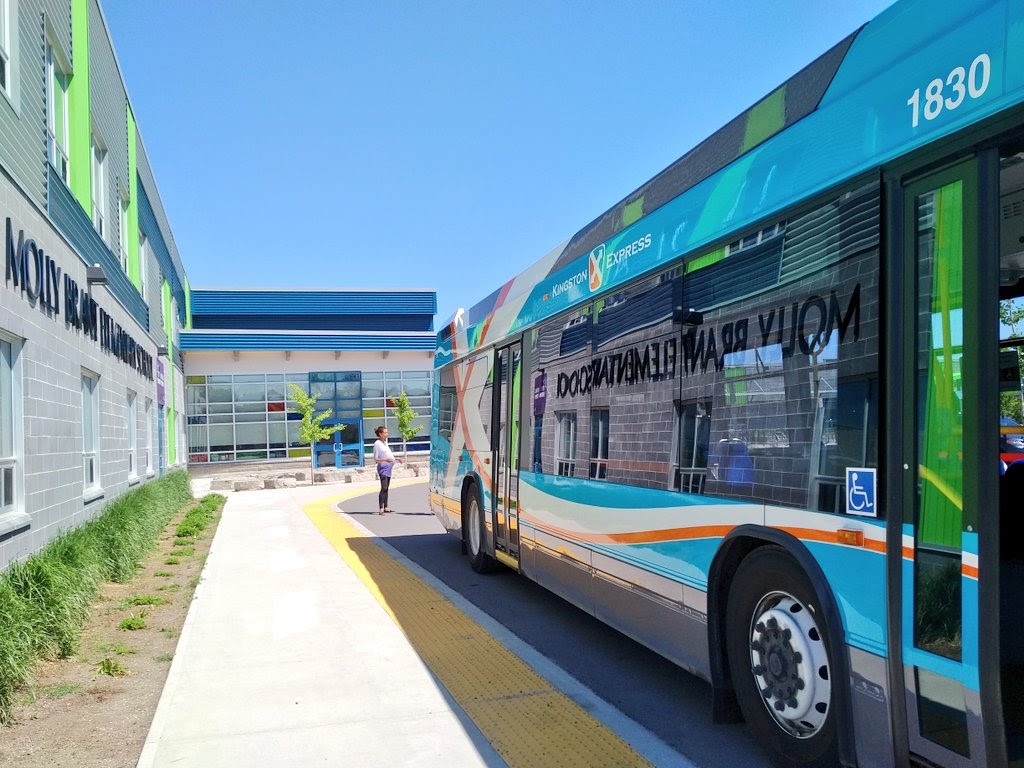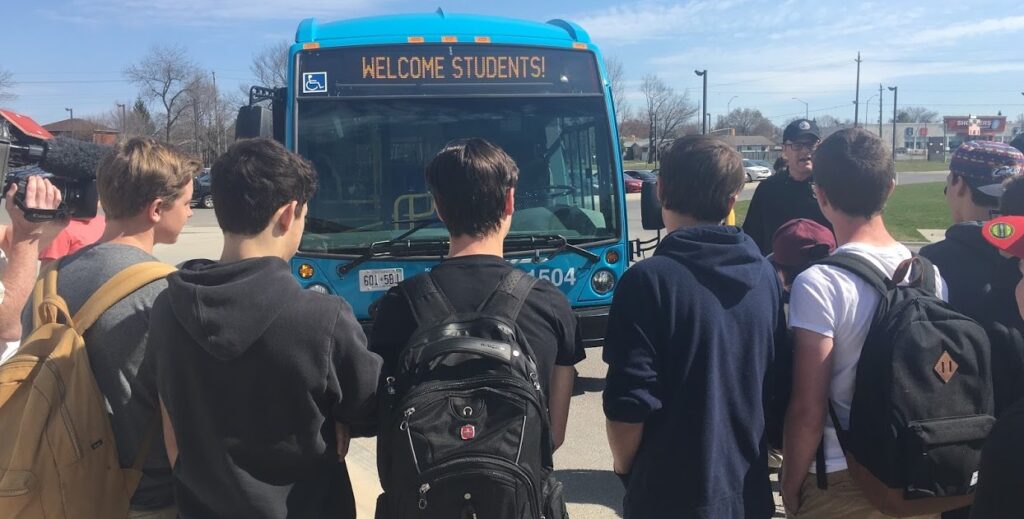The “Kingston Model” for Youth Transit Programming – the benefits public transit can have on our youth, schools and the community.

The “Kingston Model”
Kingston developed a simple but powerful model to transform public transportation and it starts with training youth. On-bus orientation and free passes have increased annual high school ridership from 28,000 to close to 600,000.
“I always start the students off in front of the bus. This is where I show them how to use the bike rack,” says Dan Hendry of the on-bus orientation program he launched in Kingston, Ontario., “I tell them the true story of when I first used it, I had never taken my bike on the bus and I actually had a popped tire… the bus pulled up I proceeded to get in front and I looked at the bike rack wondering how to do it, with forty people looking at me, cars zooming by, the bus driver unable to come off and assist, I was sweating, my helmet was flopping around it was intimidating, even as a 30 year old.”
It’s a highly relatable story––a great way to break the ice. It tells you a lot about the motivation and philosophy behind the transit orientation project, which was Mr. Hendry’s initiative.
In 2012, Kingston’s City Council recognized the benefits public transportation offers young people and decided to allow Grade nines free access to Kingston Transit. Mr. Hendry, a school board employee who worked for the City as well, noticed that the students who wanted to get their free pass had to take their student ID to one of two locations along with an itinerary showing how they’d use the pass.
These were the parameters the city established, however, many students did not regularly use public transportation and even if they were familiar, they did not get their ID until November, well into the start of the school year. These seemingly minor tasks could easily be insurmountable barriers to the exact students the program was supposed to help.
Needing a bus to get a bus pass could be the “I need my glasses to find my glasses” of the high school years. This got Mr. Hendry thinking, “When was the last time I changed my behaviour or excelled in something that someone didn’t guide or help me with?” As Mr. Hendry saw it, nobody was teaching the students how to use transit. Nobody was even really explaining why they would want to use transit, describing to them the social, economic, health and environmental benefits. Nobody was letting them meet a driver and nobody was showing them how to stop the bus or get on and off it once they had. Perhaps most importantly, nobody was highlighting the freedom public transit can grant young people, and not-so-young people, for that matter.
What was needed was a transit introduction, a little transit mentorship, something to demystify the bus and that’s what the project delivers. Each September a transit bus visits each high school, where Grade nine students are taught the ins and outs of public transit, while being given the opportunity to get their free bus pass from the comfort of their own schoolyard that very day.
The timing of this orientation is pivotal to shifting away from car culture. The fact is, that if you miss the bus in Grade nine, there might not be another one coming along for a while. Grade nine is a prime age to jump on. It’s a time when many students are going through some major life transitions and increasingly want and need the ability to travel on their own, but most are still years away from being able to get a driver’s license.
The Kingston High School Transit Pass Program shows what can happen when that moment is seized. Orientation and free passes have proven to be effective behavioural change tools.; Kingston’s high school ridership has increased from 28,000 to close to 600,000 annually.
In fact, this program has produced so much robust data that a student from the University of Waterloo, Veronica Sullivan, used it for her master’s thesis. She found that Grade 12 students, on average, use the transit pass three times more frequently than Grade 9 students. This shows that as students become older and gain more experience with transit, they become more frequent transit users.
Student feedback tells us that free transit passes facilitate more independent trips and help students participate in more extra-curricular activities they would not otherwise have been able to access.
The research study concluded that the transit pass is an important stimulant for travel independence for high school students, and the program could be applied to other mid-sized North American municipalities.
By framing the ability to use public transit as an essential life skill, and by giving students information through an authentic, low pressure experience, the program builds confidence and helps eliminate some of the barriers that might prevent high school students from taking transit, in high school, in their hometown and beyond.
Using transit, after all, is a bit like riding a bicycle and the end of MrMr. Hendry’s bussing his bike story matters here, “I know now that it is a simple thing to do – pulling it down, putting your bike on and locking in place – but without a safe and no-stress opportunity to learn – many new riders just won’t try.”

Kingston’s Newest Innovation in Youth Transit Programming:
The success of this partnership between the City and School Board has also altered Kingston Transit’s fare structure. Realizing minimal revenue from ages 14 and under, on January 1, 2017, Kingston Transit eliminated fares for ages 0-14 to encourage young families to use transit. This then allowed for the creation of their newest program, the teacher field trip pass.
This program is available for all students and educators from Kindergarten to Grade 12 and provides free access to Kingston Transit for school field trips. The purpose of the program is to reduce the cost of field trips, encourage experiential learning and to grow future transit ridership.
Prior to the introduction of the teacher field trip pass, there was little to no use of Kingston Transit for elementary school field trips within the Kingston area. In its first year, there were 600 field trips on public transit and the year before COVIDovid-19, there were 900 field trips. This pass opens up the community to schools, usually one of the most expensive – and sometimes cost-prohibitive — parts of the field trip is the cost of the chartered bus.
The field trip pass gets classes to public libraries, parks, sporting events, farmers markets, theatre and countless other community resources.

Replicating the Model:
Though Kingston has been unique in giving high school students no cost access to transit and by providing schools with field trip passes, the explicit need for orientation is applicable for all students. Though Kingston has been unique in giving high school students free access to transit and by providing schools with field trip passes. Using transit is an important skill to learn. It is transferable and requires confidence, understanding and responsibility — and this all starts with someone taking the time to show them. Giving students information through an authentic experience helps build confidence and eliminate barriers, whether mental or physical, that might otherwise prevent them from using transit.
Even if your community (school board, municipality, or transit authority) hasn’t yet developed more collaborative youth transit programing, taking your students on transit and showing them how to use it will prove to be an invaluable life skill.
Learning transit gives all students equal access to their community and can be transferred to anywhere life may take them.
Programs like these that help children and youth can have a huge effect on reducing greenhouse gas emissions throughout North America. Public transit youth programming has created so much good for Kingston, specifically youth engagement, social equity and climate action, and it has proven to be transferable to other communities.

Short Bio: Dan Hendry
Dan strives toward promoting sustainable initiatives for the Limestone District School Board. His concern for the environment is what drives him to take initiative in promoting sustainable solutions within the Kingston community. In October 2019, he gave a TEDx talk in Ottawa entitled, “Throwing Our Car Culture Under the Bus” and the video can be found on YouTube. He has also collaborated with the Federation of Canadian Municipalities to create a guide for using city–school partnerships to inspire youth to choose sustainable transportation. This program has turned into an international success, with other jurisdictions inquiring of how it is influencing its current and future ridership.
FCM Guidebook: https://fcm.ca/sites/default/files/documents/resources/guide/guidebook-engaging-students-to-increase-public-transit-ridership-gmf.pdf

















